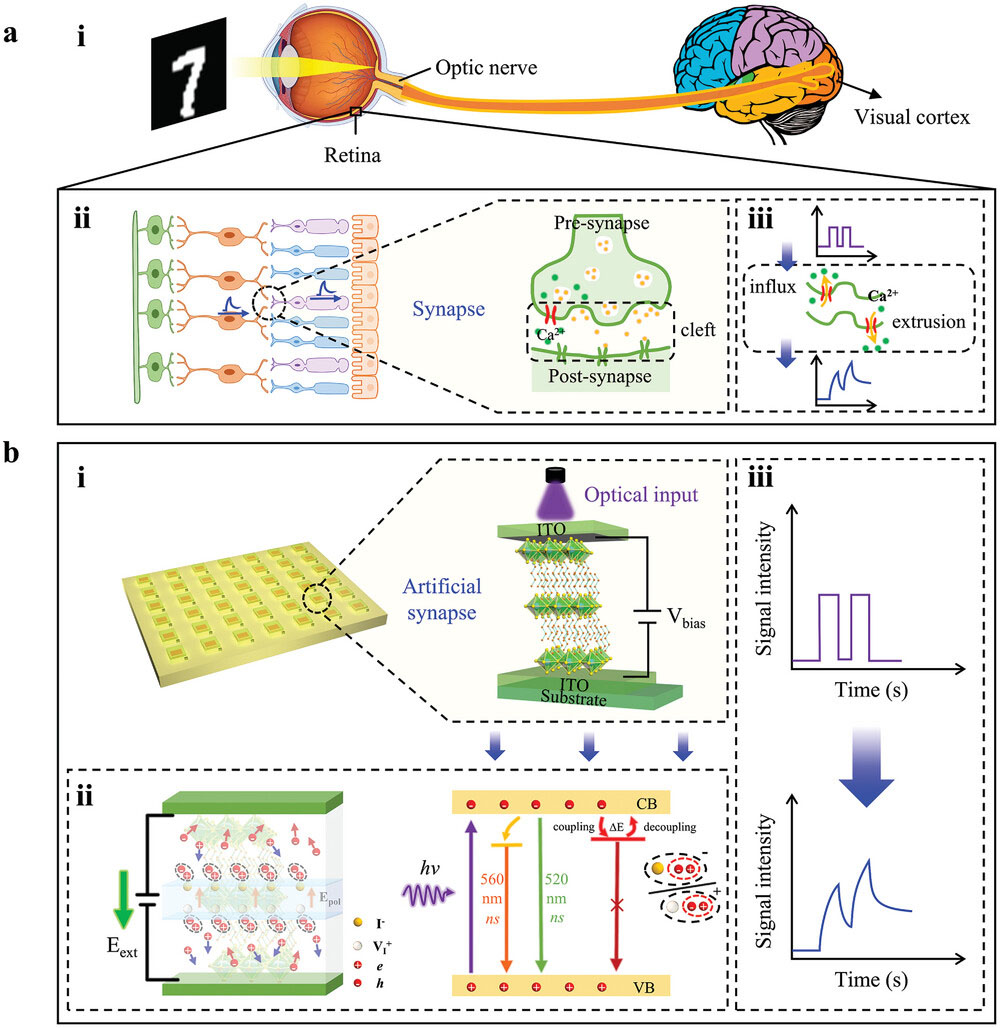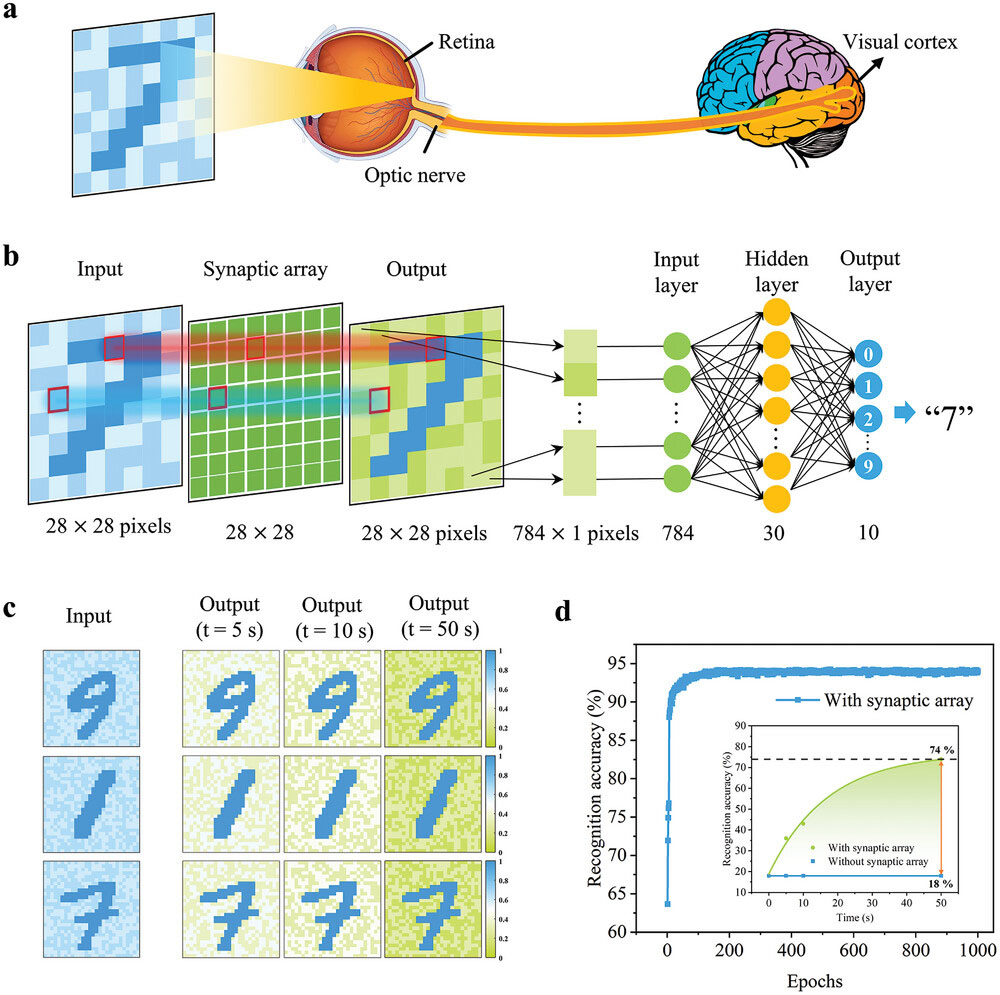| Feb 08, 2024 | |
Nanomaterial synapses bring neuromorphic computing to image sensors |
|
| (Nanowerk Spotlight) Humans effortlessly make sense of the visual world despite the fragmented mess of light that strikes the retina. Identifying objects, interpreting scenes, and recognizing faces relies on neurological computations of astonishing speed, nuance and reliability. Even the most powerful artificial vision systems pale against a toddler’s capacity to parse their surroundings. | |
| The staggering efficiency and capability of biological sight originates in the retina itself, where specialized neural circuits commence image feature extraction even before signals reach the brain. Light sensitive neurons and assemblages of supportive cells operate as adaptive processors that selectively emphasize visual elements like edges, motion and color. Further tuning continually refines detail extraction to amplify the most behaviorally relevant imagery components in complex contexts. Thorough preprocessing enables rapid inferences in later neural layers. | |
| Architecting complementary metal-oxide semiconductor cameras to enact biologically inspired filtering demands implementing massive computational resources into pixel arrays. Each microscopic photosensor node would require associated memory and processing. But silicon technologies cannot deliver such complex integrate-and-fire neurons at feasible size and energy scales. | |
| Instead, researchers from Nanjing Normal University in China now demonstrate a nanomaterials-based approach using solution grown hybrid organic-inorganic perovskites (OIHP) that intrinsically unites both photodetection and dynamic, adaptive synaptic signal modulation within single micron scale elements. | |
Key Takeaways | |
|
|
|
 |
|
| The concept of an artificial visual system mimicking the biological system. a) The biological visual system consisting of the retina (receiving and preprocessing), optic nerves (transmitting), and the visual center (processing andmemory system) and a multilayer structure of a retina. b) The artificial visual system based on a 2T vertical photodetector of ITO/(BA)2PbI4/ITO. The exciton-ion coupling is responsible for the nonvolatile photocurrent. (Reprinted with permission by Wiley-VCH Verlag) | |
The Research | |
| Exploiting unique photoconductive processes related to mobile ions and coupled excitons in crystalline OIHP films avoids much of the elaborate engineering needed for emulating neuronal behaviors like paired pulse facilitation or spike timing dependent plasticity using traditional electronic components. The innate photonics more closely reflects the concurrent perception, memory and adaptation found in the retina's interlinked photoreceptors and horizontal cells. | |
| In Advanced Materials ("Monolithic 2D Perovskites Enabled Artificial Photonic Synapses for Neuromorphic Vision Sensors"), the research team reports a novel photodetector employing monolithic 2D hybrid organic-inorganic perovskites (OIHPs) as the central active material to replicate complex synaptic characteristics. | |
| In mammals, information enters the brain through sensory neurons tuned to respond to stimuli like light, sound, or touch. The researchers' photo-sensitive synaptic mimic can similarly detect light signals while simultaneously modeling key synapse behaviors like paired pulse facilitation, spike-dependent plasticity, and memory formation. | |
| By integrating perception and information processing into a single system, the device architecture closely follows the brain's fundamental structure. Additionally, the team showed their synaptic photodetector enabled critical perception and learning functions when wired into an artificial neural network. The significant performance enhancements could enable new classes of brain-inspired technologies while also shedding light on biological intelligence. | |
| Previous efforts to develop artificial synapses for neuromorphic computing required elaborate multi-component constructions to induce the carrier trapping, localization, and gradual release dynamics necessary for memory and learning. | |
| In contrast, the researchers found that mixed ionic-electronic conductivity and strong exciton-ion coupling intrinsic to low dimensional OIHP crystals was sufficient to establish persistent non-volatile photoconductivity without requiring extensive nanoengineering. | |
| Within the crystalline lattice, mobile positive vacancy defects and negative ions can redistribute in response to external stimuli, creating internal polarization fields that influence the retention and recombination of excitons. Expert tailoring of heterojunctions that normally underpins artificial synapse designs is thus unnecessary. | |
| The team showed that simple two-terminal photodetectors fabricated by sandwiching crystals between ITO electrodes exhibited a host of neuron-like responses when subjected to patterned light pulses. | |
 |
|
| Image recognition with preprocessing based on the photonic synapse. a) Schematics of the human visual system. b) Illustration of the synaptic array for image preprocessing and an artificial neural network for image recognition. c) The input and output images at different preprocessing times. d) At decay time of 50 s, the recognition accuracy at different epochs. Inset: Image recognition accuracy for noisy images with and without preprocessing by the photonic synapse. (Reprinted with permission by Wiley-VCH Verlag) | |
| Besides detecting optical signals, the linearly scaled photocurrent persisted for nearly 90 seconds after illumination ceased, providing a continually variable memory trace. Pulsed illumination yielded analogues of short- and long-term synaptic potentiation based on tuning pulse number, width, intensity and interval. In particular, a paired pulse facilitation index of 126% confirmed the device's ability to replicate key mechanisms thought critical for sensory processing. | |
| Going beyond mimicking isolated synapse functionality, the researchers demonstrated image sensing, filtering and pattern recognition using synaptic photodetector arrays interfaced with basic neural networks. Exposing the synapse mimics to handwritten numerical digit images with added noise gave differential photocurrent decay rates that preferentially enhanced image contrast and foreground detail against the background when monitored for moderate durations. | |
| Feeding the clarified preprocessed images into a shallow neural network classifier yielded around fourfold accuracy gains overusing the raw noisy images. The nonlinear activation dynamics endowed by exciton-ion coupling allowed implementing rudimentary perception and decision making even absent the neural network. Simply monitoring the observation-history-dependent conduction states in selected photodetectors enabled recognizing facial identities from a prelearned training set with approximately 90% accuracy. | |
| The results illustrate how the reported perovskite synapse devices could lead to next generation image sensors with built-in neural processing akin to the retina. Advancements in manufacturing scalable arrays of the crystalline films using proven coating techniques may eventually allow mass production of low-cost neuromorphic vision systems. | |
| Implanting human brain-like sensory data interpretation directly into electronic image capturing hardware promises to slash the computational overhead and energy consumption associated with shuttling raw data to and from the cloud for storage or analysis in traditional architectures. | |
| Importantly, besides achieving key metrics like memory lifetime, low energy operation and voltage tunability comparable with other emerging technologies, the researchers' strategy of distilling synaptic functions down to bedrock exciton-lattice interactions has conceptual implications for hand designed artificial intelligence. | |
| Negotiating the external world's messy complexity has exerted relentless evolutionary pressure over hundreds of millions of years to shape the form and functionality of biological neural systems. As an indirect product of natural selection's inscrutable innovation rather than axiomatic first principles, the brain's design likely embodies physical computation principles beyond present theories of information processing. | |
| Synapses built by striping extraneous complexity to reveal cryptic physical effects operative in living systems may thus provide insights about the underpinnings of cognition unattainable with conventional computational paradigms. | |
| By demonstrating a credible step towards artificial systems that integrate perception and intelligence using biogenic computation, this research opens the door to qualitatively expanding machine learning's scope. | |
 By
Michael
Berger
– Michael is author of three books by the Royal Society of Chemistry:
Nano-Society: Pushing the Boundaries of Technology,
Nanotechnology: The Future is Tiny, and
Nanoengineering: The Skills and Tools Making Technology Invisible
Copyright ©
Nanowerk LLC
By
Michael
Berger
– Michael is author of three books by the Royal Society of Chemistry:
Nano-Society: Pushing the Boundaries of Technology,
Nanotechnology: The Future is Tiny, and
Nanoengineering: The Skills and Tools Making Technology Invisible
Copyright ©
Nanowerk LLC
|
|
|
Become a Spotlight guest author! Join our large and growing group of guest contributors. Have you just published a scientific paper or have other exciting developments to share with the nanotechnology community? Here is how to publish on nanowerk.com. |
|
